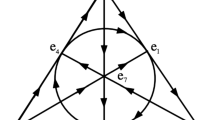Abstract
In this paper, Grand Unified theories are discussed in terms of quaternions and octonions by using the relation between quaternion basis elements with Pauli matrices and Octonions with Gell Mann λ matrices. Connection between the unitary groups of GUTs and the normed division algebra has been established to re-describe the SU(5) gauge group. We have thus described the SU(5) gauge group and its subgroup SU(3) C ×SU(2) L ×U(1) by using quaternion and octonion basis elements. As such the connection between U(1) gauge group and complex number, SU(2) gauge group and quaternions and SU(3) and octonions is established. It is concluded that the division algebra approach to the theory of unification of fundamental interactions as the case of GUTs leads to the consequences towards the new understanding of these theories which incorporate the existence of magnetic monopole and dyon.
Similar content being viewed by others
References
Georgi, H., Glashow, S.: Unity of all elementary-particle forces. Phys. Rev. Lett. 32, 438 (1974)
Graham, G.R.: Grand Unified Theories. Benjamin-Cummings, Redwood City (1985)
Mohapatra, R.N.: Unification and Supersymmetry: The Frontiers of Quark-Lepton Physics. Springer, Berlin (1992)
Witten, E.: Grand unification with and without supersymmetry. In: Castanos, O., Frank, A., Urrutia, L. (eds.) Introduction to Supersymmetry in Particle and Nuclear Physics, pp. 53–76. Plenum, New York (1984)
Baez, J., Huerta, J.: The algebra of grand unified theories. Bull. Am. Math. Soc. 47, 483 (2010). Eprint arXiv:0904.1556 [hep-th]
Pati, J., Salam, A.: Lepton number as the fourth color. Phys. Rev. D 10, 275 (1974)
Baez, J.C.: The octonions. Bull. Am. Math. Soc. 39, 145 (2001)
Pushpa, Bisht, P.S., Li, T., Negi, O.P.S.: Quaternion octonion reformulation of quantum chromodynamics. Int. J. Theor. Phys. 50, 594 (2011)
Dirac, P.A.M.: Quantised singularities in the electromagnetic field. Proc. R. Soc. A 133, 60 (1931)
’t Hooft, G.: Magnetic monopoles in unified gauge theories. Nucl. Phys. B 79, 276 (1974)
Polyakov, A.M.: Particle spectrum in quantum field theory. JETP Lett. 20, 194 (1974)
Schwinger, J.: Dyons versus quarks. Science 166, 690 (1969)
Zwanzinger, D.: Quantum field theory of particles with both electric and magnetic charges. Phys. Rev. 176, 1489 (1968)
Julia, B., Zee, A.: Poles with both magnetic and electric charges in non-Abelian gauge theory. Phys. Rev. D 11, 2227 (1975)
Morita, K.: Octonions, quarks and QCD. Prog. Theor. Phys. 65, 787 (1981)
Morita, K.: An algebraic explanation for the family structure of quarks and leptons. Prog. Theor. Phys. 66, 1519 (1981)
Günaydin, M., Gürsey, F.: Quark structure and octonions. J. Math. Phys. 14, 1651 (1973)
Dixon, G.M.: Division Algebras: Octonions Quaternions Complex Numbers and the Algebraic Design of Physics. Springer, Berlin (1994)
Buras, A.J., Ellis, J.R., Gaillard, M.K., Nanopoulos, D.V.: Aspects of the grand unification of strong, weak and electromagnetic interactions. Nucl. Phys. B 135, 66 (1978)
Müller, G.: Gauge Theory of Weak Interactions, 4th edn. Springer, Berlin (2009)
Kaku, M.: Quantum Field Theory. Oxford University Press, London (1994)
Ross, G.: Grand Unified Theories. Westview Press, Boulder (1984). ISBN 978-0-805-36968-7
Georgi, H.: Unified gauge theories. In: Proceedings, Theories and Experiments in High Energy Physics, New York, p. 329 (1975)
Kühne, R.W.: A model of magnetic monopoles. Mod. Phys. Lett. A 12, 40 (1997)
Acknowledgements
Two of us (P.S.B. & O.P.S.N.) are thankful to UNESCO and Third World Academy of Sciences, Trieste (Italy) for providing them UNESCO-TWAS Associateship. The hospitality and research facilities provided by Professor Yue-Liang Wu, Director ITP, in Institute of Theoretical Physics and Kavli Institute of Theoretical Physics at Chinese Academy of Sciences, Beijing (China) under the frame work of TWAS Associate Membership Scheme are also acknowledged.
Author information
Authors and Affiliations
Corresponding author
Rights and permissions
About this article
Cite this article
Pushpa, Bisht, P.S., Li, T. et al. Quaternion Octonion Reformulation of Grand Unified Theories. Int J Theor Phys 51, 3228–3235 (2012). https://doi.org/10.1007/s10773-012-1204-9
Received:
Accepted:
Published:
Issue Date:
DOI: https://doi.org/10.1007/s10773-012-1204-9



